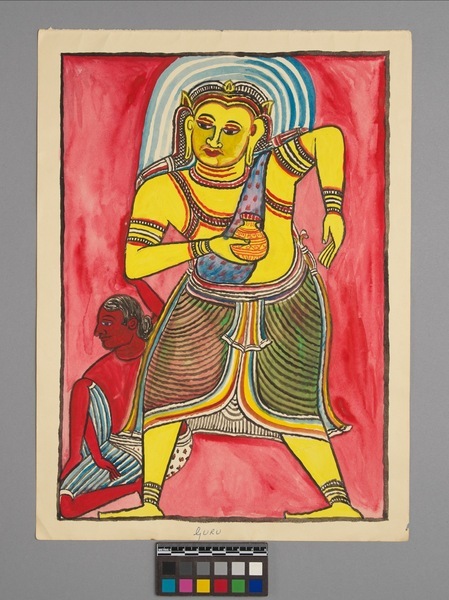Guru Item Number: 3392/7 from the MOA: University of British Columbia

Description
A watercolour painting which depicts a spiritual being with a smaller, human-like being kneeling at its feet. The being has yellow skin and is wearing a green and orange skirt that ends just below the knee. Decorations on both sides of the skirt curl outward at the hip. The bottom of the skirt has a border made up of white, yellow, blue, and red horizontal stripes. The main body of the skirt is covered in thinner horizontal stripes, and consists of two pieces which come together in the front. Four thin pieces of fabric hang down from the skirt's waistband, which is decorated with a repeating circular pattern. A blue dotted sash is draped diagonally across the being's chest. Additional adornments wrap around its chest and neck, and decorative bands encircle its biceps, wrists, and ankles. The being has half-moon shaped eyes, a small mouth, and stretched earlobes that extend down to its chin. It is wearing a headpiece that comes to a point on both sides. There is a teardrop shaped decoration on top of the headpiece, and side panels extends across the being's shoulders. One of the being's arms is raised by its side, and the other is holding a yellow jug with red decorations. At the being's feet is a smaller human-like figure with red skin and black hair. The figure is wearing blue and white striped pants, and kneeling with one leg under it. One of its arms is above its head, holding onto the yellow being's elbow. The other arm is looped underneath its remaining leg. The painting's background is red, and a rectangular black border surrounds the image. Blue and white oblong rings radiate from behind the being's head and shoulders.
History Of Use
The imagery is possibly associated with ritual healing in Sri Lanka. The set of watercolours (3392/3-34) is said to depict spirits that inhabit planets, or deviyo (minor gods) or rakshas and yakkas (evil or mischievous beings). These beings are often depicted in masked dances and exorcisms.
Narrative
The collector, Dr. Michael Egan, wrote his doctoral thesis on healing rituals in Sri Lanka. His fieldwork was carried out in the south of Sri Lanka, in the village of Kadurupokuna (Hambantota District), between Sept. 1965 and Nov. 1966.
Item History
- Made in Sri Lanka between 1960 and 1966
- Collected between 1965 and 1966
- Owned by Michael John Egan before 1977
- Owned by Carol Egan before October 2, 2019
- Received from Carol Egan (Donor) on October 2, 2019
What
- Name
- Guru
- Identification Number
- 3392/7
- Type of Item
- painting
- Overall
- height 37.5 cm, width 27.5 cm
Who
- Culture
- Sinhalese
- Previous Owner
- Michael John Egan and Carol Egan
- Received from
- Carol Egan (Donor)
Where
- Holding Institution
- MOA: University of British Columbia
- Made in
- Sri Lanka
When
- Creation Date
- between 1960 and 1966
- Collection Date
- between 1965 and 1966
- Ownership Date
- before 1977 and before October 2, 2019
- Acquisition Date
- on October 2, 2019
Other
- Item Classes
- paintings; works on paper
- Condition
- good
- Accession Number
- 3392/0007